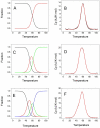Structure and stability of higher-order human telomeric quadruplexes
- PMID: 22082001
- PMCID: PMC3244555
- DOI: 10.1021/ja209192a
Structure and stability of higher-order human telomeric quadruplexes
Abstract
G-quadruplex formation in the sequences 5'-(TTAGGG)(n) and 5'(TTAGGG)(n)TT (n = 4, 8, 12) was studied using circular dichroism, sedimentation velocity, differential scanning calorimetry, and molecular dynamics simulations. Sequences containing 8 and 12 repeats formed higher-order structures with two and three contiguous quadruplexes, respectively. Plausible structures for these sequences were determined by molecular dynamics simulations followed by experimental testing of predicted hydrodynamic properties by sedimentation velocity. These structures featured folding of the strand into contiguous quadruplexes with mixed hybrid conformations. Thermodynamic studies showed the strands folded spontaneous to contain the maximum number contiguous quadruplexes. For the sequence 5'(TTAGGG)(12)TT, more than 90% of the strands contained completely folded structures with three quadruplexes. Statistical mechanical-based deconvolution of thermograms for three quadruplex structures showed that each quadruplex melted independently with unique thermodynamic parmameters. Thermodynamic analysis revealed further that quadruplexes in higher-ordered structures were destabilized relative to their monomeric counterparts, with unfavorable coupling free energies. Quadruplex stability thus depends critically on the sequence and structural context.
© 2011 American Chemical Society
Figures






Similar articles
-
Stability and structure of telomeric DNA sequences forming quadruplexes containing four G-tetrads with different topological arrangements.Biochemistry. 2004 Apr 27;43(16):4877-84. doi: 10.1021/bi0300985. Biochemistry. 2004. PMID: 15096057
-
Characterization of structure and stability of long telomeric DNA G-quadruplexes.J Am Chem Soc. 2006 Dec 6;128(48):15461-8. doi: 10.1021/ja064536h. J Am Chem Soc. 2006. PMID: 17132013
-
Inhibited complete folding of consecutive human telomeric G-quadruplexes.Nucleic Acids Res. 2023 Feb 28;51(4):1571-1582. doi: 10.1093/nar/gkad004. Nucleic Acids Res. 2023. PMID: 36715345 Free PMC article.
-
Human telomeric G-quadruplex: thermodynamic and kinetic studies of telomeric quadruplex stability.FEBS J. 2010 Mar;277(5):1098-106. doi: 10.1111/j.1742-4658.2009.07462.x. Epub 2009 Nov 27. FEBS J. 2010. PMID: 19951355 Free PMC article. Review.
-
Higher-order quadruplex structures.Top Curr Chem. 2013;330:23-46. doi: 10.1007/128_2012_350. Top Curr Chem. 2013. PMID: 22790417 Review.
Cited by
-
G-quadruplex folds of the human telomere sequence alter the site reactivity and reaction pathway of guanine oxidation compared to duplex DNA.Chem Res Toxicol. 2013 Apr 15;26(4):593-607. doi: 10.1021/tx400028y. Epub 2013 Mar 13. Chem Res Toxicol. 2013. PMID: 23438298 Free PMC article.
-
DNA G-quadruplex and its potential as anticancer drug target.Sci China Chem. 2014 Dec;57(12):1605-1614. doi: 10.1007/s11426-014-5235-3. Epub 2014 Nov 15. Sci China Chem. 2014. PMID: 27182219 Free PMC article.
-
Interrogating accessibility of telomeric sequences with FRET-PAINT: evidence for length-dependent telomere compaction.Nucleic Acids Res. 2021 Apr 6;49(6):3371-3380. doi: 10.1093/nar/gkab067. Nucleic Acids Res. 2021. PMID: 33693934 Free PMC article.
-
Hydrodynamic Models of G-Quadruplex Structures.Methods Enzymol. 2015;562:287-304. doi: 10.1016/bs.mie.2015.04.011. Epub 2015 Jun 19. Methods Enzymol. 2015. PMID: 26412657 Free PMC article.
-
Relative stability of different DNA guanine quadruplex stem topologies derived using large-scale quantum-chemical computations.J Am Chem Soc. 2013 Jul 3;135(26):9785-96. doi: 10.1021/ja402525c. Epub 2013 Jun 19. J Am Chem Soc. 2013. PMID: 23742743 Free PMC article.
References
-
- McEachern MJ, Krauskopf A, Blackburn EH. Annu Rev Genet. 2000;34:331. - PubMed
-
- Rhodes D, Giraldo R. Curr Opin Struct Biol. 1995;5:311. - PubMed
-
- Chang CC, Kuo IC, Ling IF, Chen CT, Chen HC, Lou PJ, Lin JJ, Chang TC. Anal Chem. 2004;76:4490. - PubMed
-
- Paeschke K, Juranek S, Rhodes D, Lipps HJ. Chromosome Res. 2008;16:721. - PubMed
Publication types
MeSH terms
Substances
Grants and funding
LinkOut - more resources
Full Text Sources

